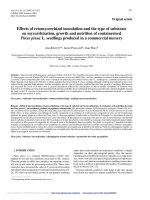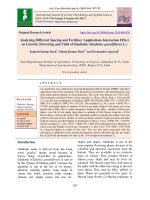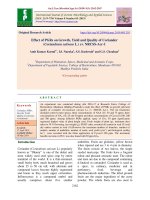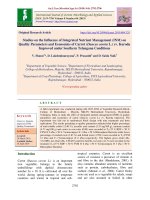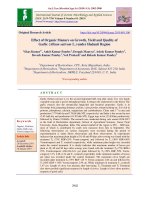Environmental challenges on leaf spot and blight of sunflower (Helianthus annuus L.)
Bạn đang xem bản rút gọn của tài liệu. Xem và tải ngay bản đầy đủ của tài liệu tại đây (571.03 KB, 10 trang )
Int.J.Curr.Microbiol.App.Sci (2020) 9(7): 2756-2765
International Journal of Current Microbiology and Applied Sciences
ISSN: 2319-7706 Volume 9 Number 7 (2020)
Journal homepage:
Original Research Article
/>
Environmental Challenges on Leaf Spot and Blight of
Sunflower (Helianthus annuus L.)
Ranjan Kumar Jena1, Nimai Charan Swain1, Shubhendu Kumar Behera1,
Nitish Kumar Jena2*, Manasranjan Rout1, Debadatta Bibhudendra Pratap1,
Angshuman Mohapatra3 and Bitish Kumar Nayak3
1
Deparment of Plant Pathology, 2Deparment of Horticulture, 3Deparment of Soil science,
Institute of Agricultural Sciences, Siksha 'O' Anusandhan (Deemed to be University),
Bhubaneswar, Odisha, India
*Corresponding author
ABSTRACT
Keywords
Symptomatology,
Defoliation,
Alternaria
helianthi, pH,
Temperature,
Kharif season,
Rabi season
Article Info
Accepted:
22 June 2020
Available
Online:
10 July 2020
Sunflower is an important major oilseed crop ranks next to groundnut and soybean at
global level. It belongs to the family Asteraceae and mostly infected by several fungal,
bacterial and viral diseases among which leaf spot and blight caused by Alternaria
helianthi was considered as one of the most destructive diseases in the sunflower growing
areas. An experiment was studied to determine the disease incidence and intensity of the
disease in both Kharif and Rabi season (2018-19) by observing the plant raised in field.
Attempt was made to evaluate the effect of different range of pH and temperature on
growth of the fungus and calculated under field condition in both Kharif and Rabi season.
The results obtained from the present investigation indicate that the incidence of the
disease and its intensity was found more during Rabi season than in Kharif under field
condition which may be attributed to suitable environment and favourable soil conditions.
Maximum dry weight growth of the fungus was observed at pH 6.0 followed by pH 5.0
and temperature at 300C-350C. The above parameters should be considered while growing
sunflower in field condition along with other protection measures to grow disease free
sunflower crop with maximum yield and good quality seed.
Introduction
Sunflower (Helianthus annuus L.) is an
important major oilseed crop ranks next to
groundnut and soybean at global level. It is
cultivated in India over an area of 21.62 lakh
ha with a production of 12.24 lakh tonnes in
different states like Karnataka, Maharashtra,
Bihar, Andhra Pradesh, Haryana and Tamil
Nadu. Karnataka occupies first position
accounting 53 per cent of total area and 35 per
cent of total production in India. Sunflower is
susceptible to a large no. of devastating
diseases. Fungal diseases are the main
constraints for it’s production and sunflower
industry worldwide (Bhutta, 1998). Leaf
blight disease of sunflower caused by
Alternaria helianthi (Hansf.), Tubaki &
2756
Int.J.Curr.Microbiol.App.Sci (2020) 9(7): 2756-2765
Nishihara is a serious threat to successful
cultivation to the crop worldwide. The crop is
affected by biotic and abiotic stresses. Among
the several biotic factors, susceptibility to
fungal diseases is one of the major constraints
for successful sunflower production. The
major diseases of sunflower in India are leaf
blight (Alternaria helianthi), wilt (Sclerotium
rolfsi) and root rot caused by Rhizoctonia
solani and Macrophomina phaseolina. Gulya
and Masirevie (1991) listed 80 pathogens
occurring on sunflower. Among this leaf
blight caused by Alternaria helianthi (Hansf.)
Tubaki and Nishihara has been considered as
potentially destructive disease in many parts
of the sunflower growing countries around the
world (Mahipal, S., Ghemawat (1989)).
The first report of disease was recorded in
India by Narain and Saksena (1973) and Kolte
and Mukhopadhyay (1973) from Uttar
Pradesh and subsequently, by Anil kumar et
al., (1974) from Karnataka. In Karnataka, the
disease occurred in epidemic form in 1987,
with a disease incidence of 95 to 100 %
(Hiremath et al., 1990). Yield loss may occur
through reduced head diameters, number of
seeds per head, and oil content or quality. A.
helianthi can cause leaf and stem lesions,
seedling blight and head rot. It has been
reported to reduce seed and oil yield up to
84%
and
33%,
respectively
(Balasubrahmanyam and Kolte, 1980, Kolte,
1985).
The pathogen survives between sunflower
crops in and on infested crop debris, as a
pathogen of safflower and cocklebur, and on
seed. Hot weather and frequent rain during
the vegetative growth stage of the crop
accelerate the disease intensity. Disease
development is favoured by 25-27 0C
temperature with at least 12 hours of wet
foliage is reported to spread rapidly during the
rainy season (Basappa and Santha Lakshmi
Prasad, 2005).
Sunflower is an important major oil seed crop
grown in different region in Odisha since a
long period of time. The conducive weather
conditions prevailing in different parts of
Odisha become the prime and favourable
factors for development and severity of leaf
spot and blight disease of sunflower caused
by Alternaria sp. Considering the fact effort
was made to study the disease under local
field condition (Bhubaneswar) both in Kharif
and Rabi season 2018-2019. Attempt was also
made to test the impact of pH and temperature
on dry weight growth of the fungus under in
vitro condition.
Materials and Methods
Study of disease symptoms under field
condition, Isolation of the pathogen and its
identification
The pathogen Alternaria helianthi was
isolated from the infected leaf sample
showing typical symptoms of the disease. The
disease samples were washed with distilled
water to remove the foreign materials. A
small disease portion (4-5 mm) of leaf along
with healthy portion from the periphery were
cut into pieces and surface sterilized with
sodium hypochlorite (0.1%) solution for 2
minutes followed by subsequent washing in
sterile distilled water for 3 times to remove
residues of sodium hypochlorite from cut
pieces. Then the diseased cut pieces were
aseptically transferred in the center of PDA
plates as well as PDA slant. They were
incubated inside a B.O.D incubator at
temperature 25±10C for 7-10 days. The pure
culture of the fungus was obtained by further
growing the culture and following hyphal tip
culture
under
aseptic
conditions
(Rangaswamy, 1972). The fungus was
identified by observing the morphological and
cultural characteristics in PDA slant as well as
plate.
2757
Int.J.Curr.Microbiol.App.Sci (2020) 9(7): 2756-2765
Weather parameters during Kharif and
Rabi 2018-19
In vitro evaluation of pH on growth of
fungus
Meteorological parameters in response to
disease incidence
Alternaria helianthi was isolated from the
infected sunflower plant and maintained as
pure culture on PDA plate. 10 days old
culture was used for testing the growth of the
fungus at different pH. The PD broth to be
used for the growth of test fungus adjusted in
different ranges of pH starting from 2.0 to 8.0
with help of Philips precision pH meter by
adding 0.1 N acid (HCL) and 0.1N alkali
(NaOH). Three replication made for each
treatment (10 days old).The fresh growth of
the fungus maintained in PDA plate (7mm)
was cut and inoculated in PD broth
maintained at different pH ranges.
In order to study the relationship of
meteorological parameters on the natural
occurrence of disease (leaf spot and blight) by
Alternaria helianthi in sunflower plant. The
observations were recorded from July to
October 2018 as Kharif crop and December
(2018) to March 2019 as Rabi crop under
field condition at experimental plot of
instructional farm, SOADU, Bhubaneswar.
The weather parameters like maximum and
minimum temperature (0C), maximum and
minimum RH (%), rainfall (mm) and bright
sunshine hours (hr) were co-related with
sunflower leaf spot/blight disease incidence.
A standard scale (0-9) basing on the intensity
of the disease appearance on sunflower leaves
was recorded through visual estimation.
Percent disease incidence was calculated by
using the formulae as mentioned below
Incidence
(%)
=
Number of leaves infected
100
Total number of leaves examined
The final growth was obtained in the PD
broth at different pH finally filtered through
whatman filter paper and which was properly
dried in hot air oven at temperature 60-800 c
continuously for 2-3 days. The final dry
weight of the fungal growth with filter paper
was taken and deducted from the weight of
the dry filter paper used for the experiment.
The net weight was recorded and mean dry
weight growth of the fungus was calculated
for each range of pH.
Effect of temperature on growth of fungus
under in-vitro condition
Total numerical rating
100
Total
number
of
units
examined
PDI =
For recording the disease incidence 100
number of sunflower plants were grown in
instructional farm (4×4m) in each season
(Kharif and Rabi). The percentage of plant
infected was calculated basing on their
number and the disease intensity was
recorded in (0-9) scale as per the formula
already given (Mayee and Dater, 1986).
Standard meteorological parameters were
obtained
from
the
Meteorological
observatory,
Department
of
AgroMeteorology, SOADU, Bhubaneswar.
The effect of temperature on dry weight
growth of the fungus was done in different
ranges like 10, 15, 20, 25, 30, 35 and 400C. 7
days old fresh culture of the fungus (7mm)
was used and inoculated to sterilized conical
flask containing PD broth.
After inoculations the flasks were kept in
B.O.D incubator adjusted in different range of
temperature like 10, 15, 20, 25, 30, 35 and
400C. For each range of temperature three
replications were maintained. The growth was
obtained in the PD broth at different ranges of
temperature finally filtered and properly dried
2758
Int.J.Curr.Microbiol.App.Sci (2020) 9(7): 2756-2765
in hot air oven at temperature 60-800 c
continuously for 2-3 days. The final dry
weight of the fungal growth was recorded and
deducted from the weight of dry filter paper
used for the experiment. The net weight was
recorded and mean dry weight growth of the
fungus was calculated.
Results and Discussion
Symptomatology
Sunflower plant were found to be affected by
leaf spot and blight disease in instructional
farm during the year 2018-19 in Kharif and
Rabi season.
The disease symptoms appeared in form of
dark brown to black spot measuring 0.2 to 0.5
mm in diameter. The spots appeared circular,
oval, and sometimes oblong and irregular in
shape surrounded by yellowish halo.
The symptoms gradually started spreading
from the lower leaves to upper leaves and
subsequently to stem, branches and flower
head. In advance stages of the disease the
spots enlarged coalesced resulting the
symptoms of blightening. The severity of the
disease results stunting of plant growth,
defoliation and poor head formation with
infected seed (Plate-1). Although the disease
symptoms of leaf spot and blight found more
or less similar both in Kharif and Rabi but the
intensity of the disease was found higher in
Rabi (Plate-2 and Plate-3).
The symptoms of leaf spot and blight
affecting sunflower was observed in India and
abroad in different times by many scientist.
The initial stage of the disease symptoms and
subsequent development of disease resulting
it’s severity was also observed by scientist
like Tubaki & Nishihara, 1969; Narain and
saksena, 1973; Kolte and Mukhopadhyay,
1973; Anil Kumar et al., 1974 and Vikas et
al., 2010).
Disease incidence in Kharif and Rabi
Sunflower plants were raised in instructional
farm (IAS) to observe and compare the
disease incidence of leaf spot/blight in both
Kharif and Rabi season. The result on disease
incidence on leaf spot/blight (Table-2)
showed that all the plants got infected by the
disease in both Kharif and Rabi (2018-19).
The disease incidence in Kharif season found
within 5-30% which was found more in Rabi
varying from 15-40% (Plate-2 and Plate-3).
While studying the disease intensity of the
infected plant it was observed that the plants
raised in Kharif season showed lower disease
intensity (40-60%) which was found higher in
Rabi i.e. 60-80% (Plate-3).
The symptoms of leaf spot/blight observed in
sunflower plant both in Kharif and Rabi were
apparently similar only except variation in
disease intensity.
The higher percentage of plant infection and
disease intensity in Rabi season may be
attributed to high inoculum load in soil and
air and the favorable climatic conditions like
temperature, relative humidity and soil
moisture prevailing during that period of time.
The optimum temperature (max. 32.50C, min.
250C), Relative humidity (74-94) and Rainfall
(420 mm) and adequate soil moisture (Table3 and Table-4) during Rabi season probably
favored higher disease incidence in
sunflower. Present finding was supported by
scientist Mayee (1994) and Mayee and
Wankhede (1997).
2759
Int.J.Curr.Microbiol.App.Sci (2020) 9(7): 2756-2765
Table.1 Showing scale and disease intensity of A. helianthi
Numerical rating
0
1
3
5
7
9
Description
No symptoms on leaf
Small, irregular brown spots covering 1% or less of the leaf area
Small, irregular, brown spots with concentric rings covering 1-10% of the
leaf area.
Lesions enlarging, irregular, brown with concentric rings covering 1125% of the leaf area.
Lesions coalesce to form irregular brown patches with concentric rings
covering 26-50% of the leaf area. Lesions also on stem and petioles.
Lesions coalescing to form irregular, dark brown patches with concentric
rings covering 51% or more of the leaf area. Lesions seen on the stem and
petiole
Table.2 Disease incidence and degree of disease intensity of Leaf spot/blight of
sunflower both in Kharif and Rabi 2018-19
Treatments
Total no. of plants
Total no. of
plantinfected(%)
Plant sown in kharif
100
Plant sown in Rabi
100
10%
38%
52%
12%
25%
63%
Disease intensity
(%) of the infected
plants
+
++
+++
+
++
++++
Table.3 Standard meteorological parameters during Kharif 2018
Month
Year
July
Aug
Sept
Oct
2018
2018
2018
2018
Temperature (°c)
Max.
Min.
32.5
26.0
32.2
25.9
32.6
25.2
32.5
22.8
Rainfall(mm)
639.2
414.2
390.4
236.8
Relative Humidity
7hr
14hr
94
79
93
77
94
74
94
60
Table.4 Standard meteorological parameters during Rabi 2018-19
Month
Year
Dec
Jan
Feb
Mar
2018
2019
2019
2019
Temperature(°c)
Max.
Min.
27.2
14.1
28.5
13.0
32.9
17.0
35.2
23.2
Rainfall(mm)
11.1
0.0
24.6
7.1
2760
Relative Humidity
7hr
14hr
89
45
95
38
94
35
92
46
Int.J.Curr.Microbiol.App.Sci (2020) 9(7): 2756-2765
Table.5 Effect of pH on dry weight growth of the fungus A. helianthi
Treatments
T1
T2
T3
T4
T5
T6
T7
pH
2.0
3.0
4.0
5.0
6.0
7.0
8.0
SE(m)+
CD (0.05)
Mean dry weight growth(mg)
4.00
116.00
125.00
176.33
228.00
134.67
132.67
1.25
3.86
Table.6 Effect of temperature on dry weight growth of the fungus A. helianthi
Treatments
T1
T2
T3
T4
T5
T6
T7
Temperature(°C)
10
15
20
25
30
35
40
SE(m)+
CD (0.05)
Mean dry weight growth(mg)
366.00
682.00
893.33
1272.00
1558.00
1522.33
1015.00
1.35
4.17
Fig.1 Effect of pH on dry weight growth of the A. helianthi
T1
T2
T3
T4
2761
T5
T6
T7
Int.J.Curr.Microbiol.App.Sci (2020) 9(7): 2756-2765
Fig.2 Effect of Temperature on dry weight growth of the A. Helianthi
T1
T2
T3
T4
T5
T6
T7
Plate.1 Leaf and head infection showing symptoms under field condition
2762
Int.J.Curr.Microbiol.App.Sci (2020) 9(7): 2756-2765
Plate.2 Disease symptom of leaf spot/blight of sunflower in Kharif
Plate.3 Disease symptom of leaf spot/blight of sunflower in Rabi
Effect of pH
The experimental finding of effect of pH on
dry weight growth of the fungus it was
observed that neutral pH 6.0 produced
maximum growth (228mg) followed by pH
5.0 (Table-5) (Plate-4).While the growth was
declined in higher pH (alkaline) i.e. 7.0 and
8.0 and it was found still less in acidic range
i.e. 2.0, 3.0 and 4.0 and minimum in pH 2.0
(4mg) (Fig.-1). The observation of effect of
pH on growth of A. helianthi was also studied
by many scientist and supported the present
finding [Jash et al.(2003), Ramjegathesh and
Ebenezar (2012)].
Effect of temperature on dry weight
growth of A. helianthi
The experimental result (Table-6) (Plate-5)
revealed that highest dry weight growth of
fungus A. helianthi was obtained at
temperature 30°C showing 1558.0 mg
followed by temperature 350C showing the
dry weight growth 1522.33 mg and they were
significantly superior to other treatment. The
dry weight growth of the fungus
comparatively less in 250C i.e. 1272 mg and
the same trend was observed minimum (366.0
mg) at 100C which gradually enhanced with
increasing range of temperature and observed
maximum within 30-350C but beyond that it
again started declining (Fig.-2). The
experimental result was found in agreement
with the finding of many scientists like
Prathibha et al., (2008) and Hubbali et al.,
(2010).
The salient findings of the present study
clearly indicates incidence of leaf spot and
2763
Int.J.Curr.Microbiol.App.Sci (2020) 9(7): 2756-2765
blight disease symptoms developed in
sunflower plant remained more or less similar
both in Kharif and Rabi (2018-19). However
the disease intensity was found higher in Rabi
which may be attributed to the climatic
condition and soil moisture and inoculum
load in crop rhizosphere.
Considering the rate of multiplication and
growth of the test fungus under in-vitro
condition, the result of the present experiment
reveals that maximum dry weight of the
fungus obtained in neutral pH i.e. 5.0-6.0
which was declined in either acidic or alkaline
range. Most favourable range of temperature
encouraging maximum growth of fungus
under in-vitro condition was found within 30350C. So climatic condition with above
favourable range of temperature and soil pH
may affect the crop with higher disease
incidence lowering yield and seed quality.
Therefore, attention should be paid while
taking the sunflower crop in a particular area
considering the above environmental factors
in order to increasing the yield and quality of
the crop.
References
Anil Kumar TB, Urs SD, Seshadri VS and
Hedge RK.1974. Alternaria leaf spot of
sunflower, Curr. Sci., 43: 93-94.
Basappa H and Santha Lakshmi Prasad M.
2005. Alternaria leaf blight/leaf spot.
In: Hegde DM (ed.), Insect Pests and
Diseases of Sunflower and their
Management, Hyderabad, Directorate
of Oilseeds Research,: 30–33.
Bhutta AR. 1998. Biological studies on some
fungi associated with sunflower in
Pakistan [PhD thesis], Pakistan: Sindh
Agriculture University.
Gulya JJ and Masireview. 1991. Common
names for the plant diseases of
sunflower (Helianthus annuus L.) and
Jerusalem
artichoke
(Helianthus
tuberosa L.). Plant Disease, 75: 30.
Hiremath PC, Kulkami MS and Lokesh MS.
1990. An epiphytotic of Alternaria
blight of sunflower in Karnataka.
Karnataka J. Agrie. Sei. 3 (3-4): 277278
Hubballi M, Nakkeeran S, Raguchander T,
Ananad T and Samiyappam R. 2010.
Effect of environmental conditions on
growth of Alternaria alternata causing
leaf blight of noni, World J.
Agricultural Sciences, 6: 171-177.
Jash. 2003. Effect of different culture media
on growth and sporulation of A. zinnia,
causing leaf blight of marigold,
Environ. & Ecol, 21(2): 321-325.
Kolte M and Mukhopadhyay HS. 1973.
Location of Alternaria spp. in
sunflower seeds, Plant Dis. Res., 5:
203-204.
Mahipal, S., Ghemawat, B. K. S., & Agrawat,
J. M. (1989). Yield losses in sunflower
due to Alternaria helianthi (Hansf.)
Tubaki and Nishihara. Archives of
Phytopathology and Plant Protection,
25, 541–544.
Mayee CD and Dater CV. 1986. A Major
disease and their management in
sunflower current states and research
priorities current trends in life science
20: 179-184, Today and Tomorrow
pointers, New Delhi.
Mayee CD. 1994. A Major disease and their
management in sunflower current states
and research priorities current trends in
life science 20: 179-184, Today and
Tomorrow pointers, New Delhi.
Narain U and Saksena SW. 1973. Occurence
of Alternaria leaf spot on sunflowcr in
India, lndian J. Mycology and Plant
Pathol. 3: 115116.
Prathibha VM, Nanjegowda D and Nagaruju
N. 2008. Effect of temperature and pH
on the growth of different isolates of
Alternaria helianthi (Hansf.) Tubaki
and Nishihara on sunflower, Mysore
2764
Int.J.Curr.Microbiol.App.Sci (2020) 9(7): 2756-2765
Journal of Agricultural Sciences.
42(1):139-142
Ramaswamy R.1972. control of rust and
Alternaria blight of sunflower, Madras
Agric, J., 63: 401-402.
Ramjegathesh
and
Ebenezar.2012.
Morphological
and
physiological
characters of Alternaria alternata
causing leaf blight disease of onion,
Internat. J. Pl. Pathol., 3 (2): 34-44.
Tubaki K and Nishihara N. 1969. A. helianthi
(Hansf) cumb Nov., Trans Br. Mycol
Soc., 53: 147.
Vikas V. Patel, Singh CP and Mishra US.
2010. Symptomatological studies on
leaf blight of sunflower caused by
Alternaria helianthi in Rohilkhand,
Adv. Biores, 1(1): 97-100.
How to cite this article:
Ranjan Kumar Jena, Nimai Charan Swain, Shubhendu Kumar Behera, Nitish kumar Jena,
Manasranjan Rout, Debadatta Bibhudendra Pratap, Angshuman Mohapatra and Bitish Kumar
Nayak. 2020. Environmental Challenges on Leaf Spot and Blight of Sunflower (Helianthus
annuus L.). Int.J.Curr.Microbiol.App.Sci. 9(07): 2756-2765.
doi: />
2765



